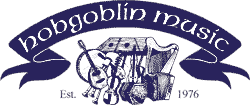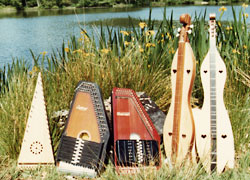
| THE HOBGOBLIN INFO SOURCE | |||
| HOBGOBLIN INDEX PAGE | HOBGOBLIN INFO INDEX | CATALOGUE CONTENTS | FRETS ONLINE SALES | SECONDHAND PRICES |
| Zither, Dulcimer, Autoharp FAQ | ||||
 |
ON THIS PAGE: Under Construction! Appalachian Mountain Dulcimer Hammer or Hammered Dulcimer Bowed Psaltery Autoharp RELATED PAGES: Stringed Instrument Care String Advice Page (soon) Tunings & Gauges |
 | ||
|
© Copyright Hobgoblin Music 1983, 1997. This text may be freely distributed in whole or in part so long as the copyright holder is clearly acknowledged. DulcimersThere are two types of dulcimer - don't get them confused they're completely different!!! Appalachian Mountain DulcimerDescended from Northern European zithers it was used mostly in old time American music. It has from 3 to 6 strings usually arranged in 3 courses and traditionally was strummed (with a very light pick). The lower two courses are used as drones, the top course for the melody. Only the top course was fretted and this was usually done with a stick called a noter. The noter gives a characteristic sound as it slides over the fret. It is a modal instrument hence the irregular fretting (see separate note on modes). There are two more modern styles of playing. One is to fret the bottom strings as well as the melody course, to play chords (eg. Joni Mitchell's LP "Blue"), the other is to change the instrument to 4 courses and fingerpick. Some dulcimers have extra frets. These are refered to as half frets, and allow greater flexibility, a six and a half fret is the most common addition, it is effectively a seventh fret, but calling it so would put out the usual notation for the instrument which is done by fret numbers. Hammer or Hammered DulcimerA larger instrument than the mountain dulcimer it is played by hitting the strings with hammers. It had a strong tradition in East Anglia especially. It is also quite strong in American music having been used in immigrant ethnic music and old time. There are different tuning systems. "All The Tunes That Ever There Were" is an excellent source of info. It is particularly apparent in the dulcimer tradition in England that the old players cared little about the source of things they played. They played what they liked - not restricting themselves to traditional material. There appears to be a dying tradition around the Birmingham area of playing this dulcimer as a plucked instrument - the repertoire not traditional, but tunes from musicals, easy listening etc. The Hammered dulcimer is a diatonic instrument, and the scales available go round the circle of 5ths. The diatonic scale is played by hitting the first 4 strings on the bass side, then switching to the first 4 on the treble side for the next 4 notes of the scale. If the lowest scale is A starting with the first course, then the D scale will start on the 4th course (the 4th note of the A scale), again using the first 4 notes on the bass (right) then switching to the treble (left) side. And so on with the scale of G, C and maybe even F. The range of the dulcimer is up to 3 octaves usually from D to D''' on a 29 course instrument. This gives the diatonic keys of A, D, G and C. Our smallest instrument with 17 courses has a range from G to A'', limiting the player to the keys of D and G. Bowed PsalteryHistory Historians have suggested that the psaltery, like the lute, came to the courts of Europe with Crusaders returning from the Holy Land. A comparison between European Psalteries and Persian Santirs or Arabian Kanums reveals a likely connection. Although this explanation seems to be well founded and the most widely accepted, two other possibilities exist. The psaltery was well known in Classical Greece and could easily have been brought to Europe by the conquering Romans along with the many other items of Greek culture which they avidly acquired. Earlier still, the Phoenicians traded all over the Mediterranean and along the Atlantic and North Sea coastlines of Europe. It is not beyond the bounds of possibility that psalteries were amongst the items traded by the Phoenicians for Cornish tin. Psalteries declined in popularity as court instruments in the later Middle Ages in favour of virginals and spinets. Like many other medieval instruments, however, the psaltery did not die out, but continued as a folk instrument passed down, in some versions completely unaltered to the present time. In the main we know from medieval paintings and sculptures that psalteries were originally played by plucking, either with the fingers or a plectrum. This does not necessarily mean, however, that in medieval or Elizabethan times the psaltery was never played with a bow. The exact origins of the bowed psaltery are shrouded in the mists of time. As a folk instrument, the use of the bow could have gone unrecorded. Tuning Tuning is best carried out with the help of a piano. The fourth longest string on the right-hand side of the psaltery, marked on some instruments with a black or brass spot, corresponds to the note C an octave above middle C on the piano. The longest string on the psaltery should be tuned to the G above middle C on the piano. The notes on the right-hand side of the instrument correspond to the white notes on a piano and the notes on the left-hand side correspond to the black accidentals on the piano. To tune a note, follow the string down to the appropriate wrest pin at the base of the psaltery then give the wrest pin a slight turn with the tuning key. Turn the key clockwise to raise the pitch and anti-clockwise to lower it, until the string of the psaltery matches the pitch of the piano note. The wrest pins of the short strings need only the slightest turn to alter pitch. The bow should be treated more or less as a violin bow. Loosen the hairs of the bow when it is not in use to avoid putting pressure on the bow for prolonged periods of time, and use rosin on the hairs of the bow to produce an even sound and prevent it from slipping on the strings. AutoharpAnother flat instrument with strings across it! It's usually strummed but can also be plucked. Chords are made by pressing down on bars at one end, which effectively fret and dampen the relevant strings for each chord. Why are Autoharp strings so expensive? The problem with autoharp strings is that are only available expensive sets. All of the wound strings have an unwound bit at each end, so you can't use normal strings to replace these - they have to be specially made. The unwound strings, however, can be replaced with guitar strings of the correct guage.
Back to the Top of the Page |